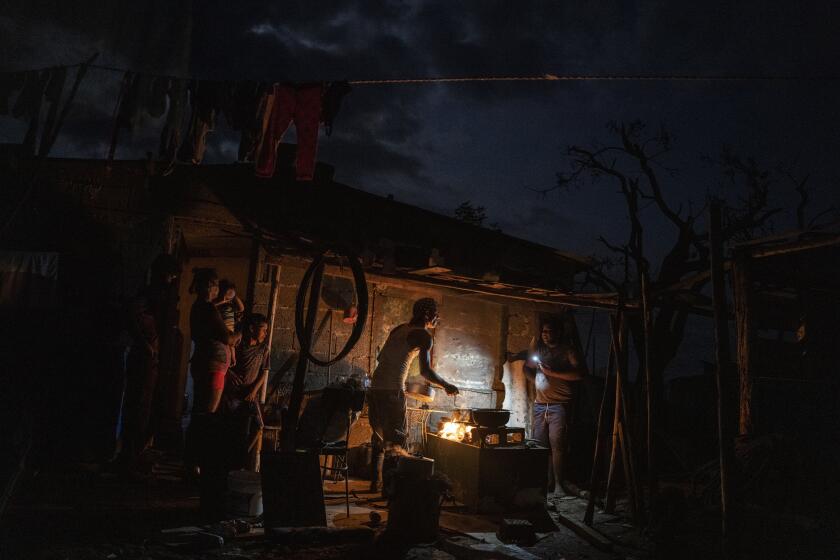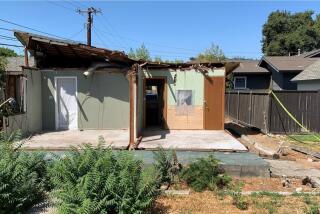Havana’s once-stately homes crumble as their residents live in fear

- Share via
HAVANA — The house on Villegas Street, in the heart of Old Havana, looks nothing like the stately two-story home it used to be a century ago, with its high ceilings, wrought iron railings, semicircular arches and stairs covered in white marble. Its former elegance is such that local lore says it used to belong to a marquise.
Today, everything inside the six-family unit is chaos.
The roots of a tree protrude through the wall of a makeshift toilet where birds have made their nests. The roof is propped up. There is rubble and fresh sand scattered everywhere. The walls seem to tilt and the façade has completely disappeared, exposing a patio where one can see freshly washed clothes hanging.
The structure is one of many once-luxurious houses in the island nation that in recent years have partially collapsed or show visible damage. Barely 100 meters away, also on Villegas Street, a similar building fell in earlier this month, causing three deaths.
Residents say they have repeatedly asked authorities for help to no avail. Years of neglect, inclement weather and a deepening economic crisis only aggravate the fear that their home will eventually collapse.
“How can we not live in fear? Every time it rains I feel like small pebbles come falling down on me,” said Maricelys Colás, a retired 64-year-old who has lived in the house with her 85-year-old mother for 59 years. “And a collapse doesn’t warn you.”
“Did you see the war correspondent’s uniform?”
The Cuban government has in the past acknowledged the problem of housing deterioration, but says the lack of material resources prevents it from tackling it. Yet, many Cubans wonder why the pace of investment in tourism megaprojects such as hotels — a vital business sector that has failed to take off in at least the last two years — is not slowing down to address the dire housing crisis.
The house on Villegas Street was built two centuries ago on a plot measuring about 15 meters by 60 meters. Three families live on the ground floor, where there used to be a main patio and rooms for the domestic staff. Three other families live on the more deteriorated top floor, where cracks abound and the staircase creaks as you climb it.
All of the residents say the building once belonged to the Marquise of Pinar del Río, a title granted by the Spanish crown when the island was part of its domains. The Associated Press could not verify that, but its elegant design is visible.
Nowadays, everything smells of mold.
The AP interviewed all the residents of the building except an elderly man who was temporarily staying in a relative’s house. Every one reported appealing to the government, requesting to live elsewhere or to have access to materials for repairs. They said they never received a response.
The Cuban government did not respond to an emailed request for comment.
Mario Luis Poll, a 57-year-old art restorer who has lived in the building for 19 years, walks around his unit showing a reporter all the repairs he has done to try to hold the ceiling together after the floor of the room above collapsed.
At a time when Cuba is urging the Biden administration to ease U.S. sanctions that it says stifle hurricane recovery efforts, Russian oil has flooded into the island.
Right above him, 47-year-old musician Marcos Villa faces a different problem: Foliage from a tree is growing out of his improvised bathroom.
“The struts [wooden posts that are supposed to support the roof of the entire construction] are almost just for decoration,” Poll said, shrugging in a sign of resignation.
Cuba’s housing crisis is one of the most pressing challenges facing the island, where a humid climate, the passage of hurricanes and other storms, poor maintenance and a low completion rate of new ones are usually among the top complaints of residents.
Cuba’s director of housing, Vivian Rodríguez, said earlier this month that the island has a housing deficit of 800,000 homes, especially in the provinces of Havana, Holguín, Santiago de Cuba and Camagüey.
Government figures from 2020 say Cuba had 3.9 million homes, out of which nearly 40% were deemed to be in only fair or poor condition.
“The situation is critical,” said Abel Tablada, professor at the Faculty of Architecture of the Technological University of Havana, adding that rebuilding and restoring partially collapsed buildings “requires many resources that the Cuban state does not have in these moments of acute crisis.”
The residents of the house on Villegas Street, tired of asking authorities for help, can only sigh about the fate of the former mansion they inhabit.
“If those marquises came back to life and saw this house, they would surely die again,” joked Elayne Clavel, 26, wife of musician Villa.
More to Read
Sign up for Essential California
The most important California stories and recommendations in your inbox every morning.
You may occasionally receive promotional content from the Los Angeles Times.















